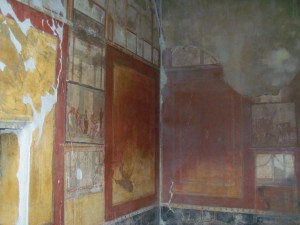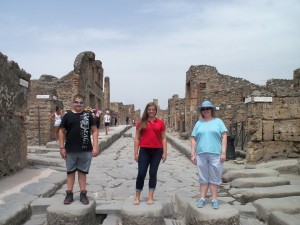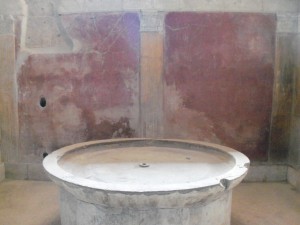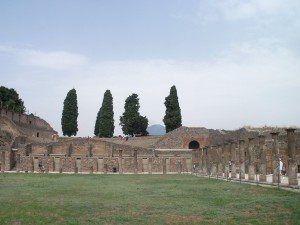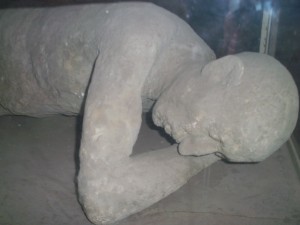During our trip to Italy, we spent a few hours in Pompeii. If you’re in Italy, this is a must-see. I took Latin in high school, so I knew a lot about Pompeii, but this is definitely one of those places that must be seen to be understood and appreciated. Pompeii was a Roman city that was buried when Mount Vesuvius exploded in 79 AD. The city was completely taken by surprise and the citizens died from the poison gas. The city was literally buried in ash, which completely preserved it in an intact state in the middle of daily life. Excavations are still taking place and there is still much of the city that has not been uncovered.
You will not believe the size of the city. This was a large, independent,
metropolis. It is a huge area. We were there for two hours and saw only a fraction of it.
The Highlights
I was blown away by how real this made the Romans feel to me. You walk their streets, peer into their shops and walk through their homes. We had a private guide for our visit, who was able to point things out and show us details we would have missed. You are walking through a city that is just missing most of its roofs. For me, there were three highlights:
- The Baths. We visited a carefully preserved spa that had men’s and women’s locker
rooms, baths, and steam rooms. The women’s side is preserved intact, so you can see the mosaics and finish work. The men’s side is taken apart so that you can see the clever duct work that moved the hot water and created steam. The baths were an important part of Roman life and until you walk through them and feel how carefully designed they were, you don’t really understand the lifestyle.
- The whorehouse. This was completely legal and considered necessary.
Pompeii was a seaport so many sailors came into town seeking company. The whorehouse has stone beds and the walls have frescoes that are a menu of sorts, depicting the different acts available so that sailors could select their services even if there was a language barrier. Along the streets, there are carvings of male genitalia pointing the way so sailors could easily find their way to the house. This was one of the busiest spots on the tour and our private guide was able to get us in past the crowds. Before we went, she took me aside and asked if I was ok with going there, since our 14 year old son was along. I appreciated her asking, but had no problem with it.
- The villa. In recent years a beautiful villa has been excavated and left open to the public so you can walk through the home and see the frescoes and mosaics and really feel what it is like to be inside a Roman home, which is very different from our homes. This made the Romans come to life and was an experience of a lifetime.
Other Sights
We also enjoyed seeing the gladiator training school. The gladiators lived in dorms and practiced on a practice field and in a small arena here before being sent to the Colosseum in Rome. It was fascinating to see the Colosseum in Rome then come here and see where they learned their skills.
I also loved the streets themselves. There is something amazing about walking down a street where Roman carts went before you. They also have stepping stones across the street to allow pedestrians to cross without getting wet or muddy. It was all very thought out and the streets were laid out like a grid.
We were also struck by the suburban strip mall feel to the main streets, where shop after
shop is lined up. Our guide told us they had pocket doors on the shops, since the city was so tight. Those clever Romans.
I wish we had had time to go to the museum in Naples where most of the artifacts have been taken. Unfortunately, Pompeii is mostly just empty shells of buildings. We did see a few casts of people (my son was fascinated, I found them slightly horrifying). The actual body was essentially vaporized, leaving a cast behind.
Preparing for Your Visit
If you go:
- Wear sneakers. The streets are cobblestone and there are hills.
- Bring water. There are fountains throughout the city, but when we were there, they were not functioning.
- Wear a hat. There is NO shade anywhere inside Pompeii.
- Plan out your walk. If you are on your own, get a map and choose the highlights you want to see. You cannot see it all without dropping dead from exhaustion, so choose the highlights.
- Allow lots of time. We were there for 2 hours and I wish we had had more time.
A Shopping Tip
I have one last tip for you about the area. Outside the gates of Pompeii there are tons of
tacky souvenir stalls (and they are really bad), but our guide steered us into a cameo shop. I would never have seen it. If you are facing the entrance gate, it is on your right hand side in the building behind the outdoor restaurants. They claim to be a place where cameos are handmade and you are walked past an old man who is working, but it’s hard to believe he alone produces all the product they have there (I’m not questioning the handmade nature of the cameos, just that it is unlikely that one older man is making them all when they are selling many every day). There is a short video you can watch about how cameos are made (they are carved from shell commonly today, but used to be from stone and glass) if you’d like some history. Downstairs is the actual shop, with cases and cases of cameos. If you select a cameo they will not only size rings on the spot, but the artisan will sign the back of it and inscribe your initials onto the back. I thought the prices were reasonable and the quality was excellent.
During our trip to Italy, we spent a few hours in Pompeii. If you’re in Italy, this is a must-see. I took Latin in high school, so I knew a lot about Pompeii, but this is definitely one of those places that must be seen to be understood and appreciated. Pompeii was a Roman city … Read more

